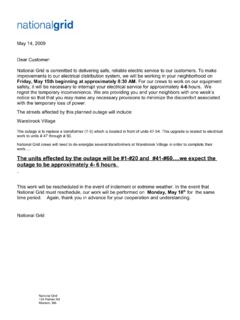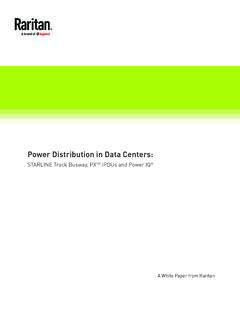Transcription of Chapter 5: Electricity
1 1 Chapter 5: Electricity Vanessa Martin 0776 757 3907 Key headlines Electricity demand increased in 2021 to TWh, up by per cent from 2020. The increase was primarily a result of the response to the Covid-19 pandemic, which severely restricted the activity of business and industry in 2020 but had a smaller effect in 2021. Demand increased in all sectors in 2021 compared to 2020. The reduction of restrictions in response to Covid -19 led to an increase in industrial and commercial Electricity consumption, whilst cooler temperatures increased domestic consumption. Electricity supply increased in 2021, due to higher demand for Electricity , but UK generation fell with higher supply from net imports. Total Electricity supplied in 2021 was TWh, with net imports of TWh, per cent of Electricity supplied.
2 Electricity generation fell to a record low of TWh in 2021, per cent less than in 2020. Generation from renewable sources decreased per cent to TWh in 2021. This was driven by less favourable weather conditions for wind, hydro and solar generation. In particular, wind generation dropped to TWh in 2021, down 14 per cent despite increased capacity. This was because of unusually low average wind speeds across most of 2021. Fossil fuel generation increased per cent in 2021 to TWh. Increased demand for Electricity and lower renewable generation increased the need for fossil fuel generation. The proportion of Electricity generation coming from renewable sources fell in 2021 but was still the second highest share on the published data series.
3 The renewable share was per cent, down by percentage points compared to 2020, lower than the share of generation from fossil fuels ( per cent), a contrast to the previous year. Decreased nuclear and renewable Electricity generation meant the share of generation from low carbon sources was per cent in 2021, down from per cent in 2020. Total net imports were a record TWh in 2021. Total imports were TWh in 2021, up per cent compared to 2020, while total exports were down per cent on 2020 to TWh. Inter connector capacity rose to 7 .4 GW in 2021 with new operational cables between the UK and Norway (North Sea Link), and a second link to France (IFA 2). Total de-rated generation capacity rose to GW in 2021, a per cent increase on the GW capacity in 2020.
4 C apacity for renewable technologies increasing by per cent to GW while fossil fuel capacity remained unchanged at GW and nuclear capacity unchanged at Electricity Flow Chart 2021 (TWh) Notes on flow chart 3 Electricity demand increased in 2021 to TWh, up by per cent from 2020. Though Electricity demand had been declining year on year since 2015, the increase seen in 2021 was primarily a result of the response to the Covid-19 pandemic, which severely restricted the activity of business and industry in 2020 but had a smaller effect i n 2021. Despite the increase in 2021, Electricity demand remained below 2019 s Electricity demand. In line with the increased overall demand, there was a per cent increase in final consumption of Electricity compared to 2020.
5 Final consumption refers to Electricity consumption by end users, excluding Electricity consumed in the process of generation and transmission or distribution losses. Chart Electricity consumption by sector, 2000 to 2021 (Table ) Demand increased in all sectors recovered in 2021 compared to 2020. The reduction of restrictions in response to Covid-19 led to an increase in industrial and commercial Electricity consumption, whilst cooler temperatures increased domestic consumption. When comparing 2021 to 2020, industrial use of Electricity , including iron and steel, increased per cent, while consumption by other final non- domestic users, including the commercial sector, increased by per cent. Despite these increases, consumption in both sectors remained below 2019 levels, with warmer average temperatures in the second half of the year reducing the potential increase when Covid-19 restrictions were lifted.
6 Domestic consumption increased by per cent in 2021. This reflected cooler temperatures increasing electric heating demand, particularly in the first half of the year when Covid -19 restrictions meant that people continued to spend time at home, including work ing from home. It may also reflect voluntary changes in behaviour even once restrictions were lifted, for example increased working from home or businesses introducing hybrid working. Total Electricity demand is larger than Electricity consumption. This is because total demand also accounts for Electricity consumed in the process of generation or to produce fuel for generation, as well as for Electricity lost in transmission or distribution from where it is generated to where it is consumed.
7 The full breakdown of Electricity demand is shown below. 4 Chart Share of total Electricity demand split by sector, 2021 (Table ) Domestic users accounted for almost a third ( per cent) of total Electricity demand in 2021. Consumption by industry represented 25 per cent and commercial consumption represented 20 per cent. Compared to 2020, the domestic share increased percentage point, the industrial share increased percentage point and the commercial share by percentage points, with fewer Covid -19 restrictions impacting industries and businesses. Electricity supply increased in 2021, due to higher demand for Electricity , but UK generation fell with higher supply from net imports. Demand for Electricity is mainly met by UK generation and supplemented with imports from Europe when price differentials are favourable.
8 Electricity generation measures what is generated while Electricity supply measures what was supplied to the grid, excluding the Electricity used in the process of generation or consumed on site by the generator. Total Electricity supplied plus imports needs to match with demand to ensure there is always enough Electricity available. Total Electricity supplied in 2021 was TWh, with net imports of TWh, per cent of Electricity supplied. Chart Electricity generated by fuel, 2000 to 2021 (Table ) Electricity generation fell to a record low of TWh in 2021, per cent less than in 2020. This was despite the increase in demand as Covid -19 restrictions were partly lifted, with high net imports accounting for 5 the difference.
9 The generation by Major Power Producers (MPPs) was the lowest value on the published data seri es, down per cent on 2020 to TWh. This continues a trend for lower MPP generation, with the emergence of greater numbers of smaller renewable sites, and higher net imports. Generation from autogenerators and other generators decreased by per cent to TWh in 2021, as less favourable weather conditions limited generation from smaller renewable sites. Generation from renewable sources decreased per cent to TWh in 2021. This was driven by decreased wind generation, which was TWh in 2021, down 14 per cent despite increased capacity. This was because of unusually low average wind speeds across most of 2021. Weather conditions were also less favourable for hydro and solar generators, with lower than average rainfall leading to a 20 per cent decrease in hydro generation and lower average sun hours meaning that solar generation decreased by per cent.
10 In contrast, there was a per cent increase in generation from bioenergy to TWh. Fossil fuel generation increased per cent in 2021 to TWh. Increased demand for Electricity and lower renewable generation increased the need of fossil fuel generation. Gas continued to be the dominant fossil fuel, generating TWh of Electricity in 2021, an increase of 11 per cent from 2020. There was also an increase of 19 per cent in coal generation to TWh, from the record low value in 2020. Just four coal-fired power stations remain in the UK, with plans to phase these out by October 2024. Nuclear Electricity generation was TWh in 2021, down per cent compared to 2020. This was the lowest amount in more than twenty years as all of the UK s nuclear plants were on outage at times during the year.














